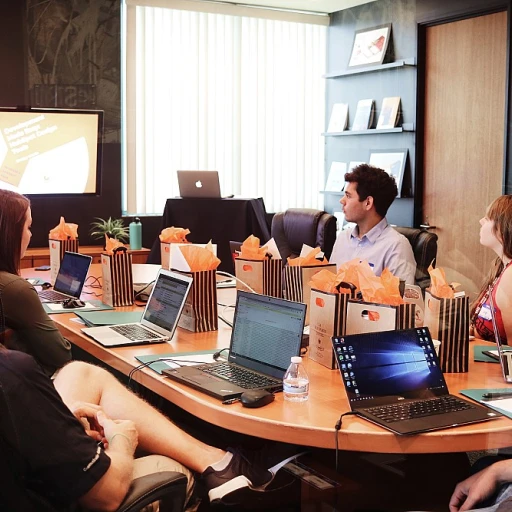Understanding the Need for Reskilling
Recognizing the Importance of Reskilling
In today's rapidly evolving job market, the concept of reskilling has become more than just a trend—it's a necessity. With technological advancements and shifting industry demands, businesses are realizing that reskilling their workforce is crucial for staying competitive. A significant challenge that organizations face is ensuring their employees possess the necessary skills to adapt to these changes. This situation underscores why understanding the importance of reskilling is a key starting point for any organization.
The ever-changing landscape of job roles and responsibilities means that the skills relevant today may become obsolete tomorrow. Therefore, cultivating a workforce capable of adapting to new challenges is critical. This entails not only acknowledging the need for reskilling but also proactively fostering an environment where continuous learning and development are ingrained in the organizational culture.
Furthermore, reskilling is not just about individual development but also about aligning the workforce's capabilities with the company's strategic goals. As businesses pivot and explore new avenues, they must ensure their team is equipped with the right skills to drive innovation and growth. A workforce that is continuously evolving through effective reskilling initiatives ensures that the organization is not only meeting current demands but is also prepared for the unforeseen needs of the future.
By empowering employees with new skills for tomorrow's jobs, companies can build a resilient workforce ready to tackle future challenges. Such an investment in reskilling garners loyalty, boosts morale, and, importantly, positions the organization to thrive amidst uncertainty. For more insights on how empowering employees can lead to organizational success, check out our detailed perspective on
empowering employees with new skills.
Identifying Skills Gaps in Your Organization
Pinpointing Skill Shortages
Before embarking on a reskilling journey, it is essential to identify where the skill gaps lie within your organization. Understanding these gaps enables the creation of targeted and effective reskilling programs. This step acts as a bridge between recognizing the need for reskilling and launching the actual initiatives.
Companies often find themselves with a mismatch between the skills employees currently possess and those required to meet evolving industry demands. By conducting a comprehensive skills audit, organizations can provide clarity on the areas needing attention. This method helps in understanding which abilities are lacking and where to focus the reskilling efforts. Consider using employee assessments, feedback surveys, and data analytics to collect valuable insights regarding skill deficiencies.
It's crucial to involve employees in this process, as they can provide first-hand insights into the specific challenges they face and the competencies they need to enhance. This collaboration not only helps identify gaps more accurately but also fosters a sense of involvement and commitment among team members, paving the way for a smoother transition into reskilling initiatives.
Moreover, as industries undergo a digital transformation, it’s inevitable that digital skills are at the forefront of the required competencies. However, other areas such as critical thinking, problem-solving, and leadership qualities should not be overlooked. Keeping a balanced view is key to developing well-rounded teams that can adapt to various challenges. For more insights on preparing for the workforce of tomorrow, explore the strategies discussed in "
reskilling for the digital shift."
Determining skill gaps is the first strategic step that guides the entire reskilling agenda, ensuring that every effort is aligned with the overarching business objectives and the future landscape of work.
Implementing Effective Reskilling Programs
Building an Effective Framework for Skill Transformation
Once the need for workforce skill enhancement is understood and skill gaps have been identified, organizations must focus on implementing efficient reskilling programs to tackle these deficiencies. The aim is to create a workforce equipped with the skills necessary not only for current demands but also for future challenges.
A structured and strategic approach is crucial for achieving the best outcomes from reskilling initiatives. It's important to start with a clear vision that aligns with your organization's overall goals and objectives. This ensures that every reskilling effort is consistent and goal-oriented.
Involve key stakeholders from various departments to gain insights into the types of skills that are currently lacking and will be needed in the future. Cross-functional collaboration helps in building curricula that are not only relevant but also comprehensive. Tailoring programs to specific departmental needs ensures that employees across the organization have a clear path toward skill development.
Targeted training is a fundamental aspect of successful reskilling programs. By focusing on specific areas where skills are lacking, businesses can efficiently allocate resources and time. Tailored training schedules allow employees to learn at their own pace while maintaining productivity in their current roles.
Additionally, continuous
improvement in reskilling strategies should be embedded within the framework of these programs. This involves regularly evaluating the effectiveness of the training and making adjustments as necessary. Feedback loops can help gather insights from participants, ensuring the training remains relevant and impactful.
Finally, consider the integration of mentorship and peer-learning opportunities. Employees can benefit greatly from sharing experiences and insights with colleagues, thereby reinforcing the learning process. By fostering an environment of collaboration and support, organizations can maximize the benefits of their reskilling programs and ensure a sustainable growth trajectory.
The Role of Continuous Learning in Employee Development
The Importance of Sustained Learning in Career Growth
In today’s rapidly changing work environment, merely reskilling employees once is no longer sufficient. As organizations evolve and adapt to new technologies and methodologies, continuous learning becomes an integral part of employee development. This sustained learning journey not only helps bridge the skills gap but also empowers employees to stay relevant in their respective fields.
A culture of ongoing learning fuels innovation and agility within a company. When employees are regularly exposed to new knowledge and skills, they bring fresh ideas and adapt more swiftly to market changes. This dynamic approach contrasts sharply with static, one-time training programs, which quickly become obsolete in the face of swift advancements and disruptive changes in the business landscape.
Furthermore, continuous learning keeps employees engaged. It creates a sense of purpose and belonging as individuals feel seen and nurtured in their professional growth. Engaged employees are more productive, leading to higher retention rates, which is beneficial for the organization’s overall growth and stability.
Integrating continuous learning can take many forms – from formal training sessions to online courses and workshops. Leveraging technology, as discussed in other sections, facilitates access to these varied learning opportunities, making them more convenient and accessible.
Ultimately, continuous learning is an investment in both the individual and the organization. By fostering an environment that encourages perpetual education and reskilling, organizations not only meet the challenges of today but also prepare for the unknowns of tomorrow, ensuring long-term success and sustainability.
Leveraging Technology for Skill Development
Harnessing Technology to Enhance Workforce Skills
In today's rapidly evolving workplace landscape, technology plays a transformative role in enhancing workforce skills and addressing skills gaps. As discussed in previous sections, understanding the skill deficiencies within an organization and implementing effective learning programs are foundational steps. However, the integration of advanced technologies can significantly amplify these efforts, making the reskilling process more efficient and impactful.
One of the primary ways organizations can leverage technology is through the use of e-learning platforms and digital tools. These platforms provide flexible learning opportunities that allow employees to engage in training at their own pace and convenience, accommodating different learning styles and schedules. This flexibility helps maintain engagement and fosters a more inclusive learning environment where everyone has the opportunity to thrive.
Moreover, data analytics and artificial intelligence (AI) can play a crucial role in personalizing the learning experience. By analyzing employee performance data, AI algorithms can tailor training programs to address specific skill gaps and recommend targeted resources that align with individual learning needs. This targeted approach not only enhances the effectiveness of training but also ensures that employees remain motivated and invested in their professional growth.
Gamification is another innovative way technology can be used to make reskilling programs more engaging. By incorporating game-like elements into training modules, employees can experience a more interactive and enjoyable learning process. This approach boosts motivation and encourages a competitive spirit that can lead to better retention of new skills.
Virtual and augmented reality technologies also offer immersive learning experiences that allow employees to practice real-world tasks in a safe and controlled environment. These technologies are particularly beneficial for roles that require hands-on experience or involve complex procedures, providing a realistic training ground without the risk of costly mistakes.
As we navigate the future of work, embracing technology in reskilling strategies is crucial for building a resilient and adaptable workforce. By leveraging these tools, organizations can ensure they are well-prepared to meet the demands of an ever-changing job market, ultimately fostering a culture of continuous learning and innovation.
The Future of Work and Reskilling Strategies
Adapting Strategies in Light of a Changing Work Landscape
As we look towards the future of work, the evolving job market is clear in its demand for strategic reskilling initiatives. The rapidly advancing technological landscape and the shift towards automation pose both challenges and opportunities for businesses aiming to stay ahead.
The concept of lifelong learning becomes increasingly significant. As previously mentioned, continuous learning is a cornerstone of effective employee development. To remain competitive, organizations must foster a culture that encourages ongoing education and skill enhancement. This culture not only promotes growth but also equips employees with the adaptive skills necessary for forthcoming job roles.
Furthermore, technology is not just a disruptor; it acts as an enabler within reskilling strategies. Embracing AI-driven tools and platforms can significantly enhance the efficiency of reskilling programs. By utilizing data analytics, companies can precisely identify skill gaps and personalize training modules accordingly. This integration of technology facilitates a faster adaptation to industry changes, ensuring employees are prepared for the future.
While the precise projections of the future job market remain uncertain, a proactive approach in workforce reskilling ensures organizations are not only reactive but also resilient and adaptable. By continuously updating skill sets and embracing innovative strategies, companies safeguard against obsolescence and thrive in an ever-evolving economic environment. Reskilling is an investment in the future, a necessary component of a robust business strategy designed to navigate the complexities of tomorrow's work landscape.



